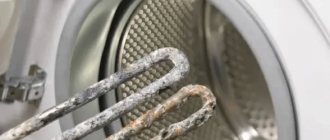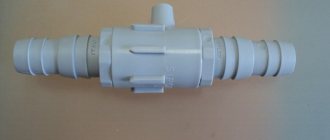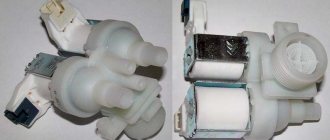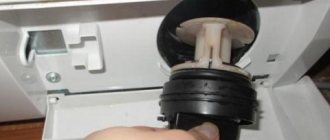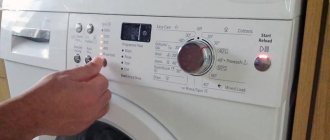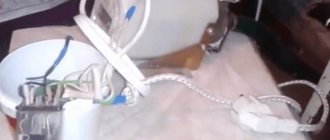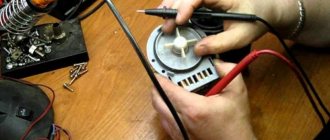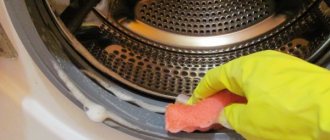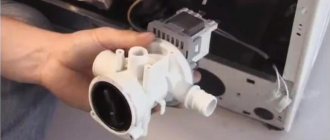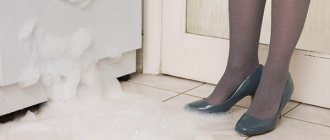Drain hose
The simplest method allows you to drain the water the fastest. Procedure:
- Turn off the power, turn off the water supply.
- Disconnect the drain hose from the rear panel.
- Pull the outlet out of the sewer pipe.
- Place the end of the hose in a container (bowl or basin) located below the level of the washing tank. The container required is low; it is difficult to pour into a bucket using this method.
If the washing machine does not drain water in this way, then it is equipped with protection against leakage from the sewer hose.
Inside the housing, manufacturers make an additional loop with a drain hose or install a plastic elbow, so the drain hose is always above the level of the tank. Most often found in Bosh and Siemens washing machines. See also -
Samsung washing machine fault codes
Reasons why water does not drain in a washing machine
The lack of drainage in the washing machine is a consequence of an unusual situation.
If the washing machine stops draining water:
1.You have selected
non-draining
wash cycle , such as delicate wash or woolen wash.
Solution.
Check if you have a special mode installed. Information about modes that do not involve draining water is contained in the instructions for the washing machine.
2.
The drain hose is pinched.
The drain hose connects the machine to the sewer. It may be twisted or pinched. Water physically cannot go down the drain.
Solution.
Move the drain hose to the proper position and try to start the water drain mode.
3.Clogged
drain filter or sewer.
Solution.
You can remove the blockage yourself or invite a washing machine repairman.
4. Out of order
pressure switch (water level sensor), control board or pump pump. These parts can only be repaired or replaced with new ones by a professional technician.
Solution.
Order a washing machine repair service and try draining the water from the unit yourself before the technician arrives.
Emergency hose
Designed specifically for draining water in case of breakdown. It is usually located in a special hatch at the bottom of the front panel and is closed by a small door, where the drain filter is also located. In some cases, the drain mechanism is implemented in the form of a retractable plastic channel. If you do not see the hatch on the front panel, then it is located under the plastic decorative panel at the very bottom. This design is found in Indesit washing machines.
Draining order:
- Open the hatch door and remove the thin emergency hose from the niche.
- Place a flat, wide container of suitable height under the hatch. Remove the plug from the hose and place it with the outlet hole in the container.
- Monitor the process so that the water does not spill.
Important:
all procedures for draining water are carried out only after disconnecting the washing machine from the electrical network and water supply!
Disadvantages of the method:
- Long draining process – up to 30 minutes;
- The emergency hose is often clogged with scale or other debris, so the water will not drain;
- Some models do not have an emergency hose.
Advice:
To speed up the process, tilt the machine against the wall, open the drum hatch, and scoop out some of the water by hand. We drain the remaining water through the emergency hose.
Method number 4: Direct, through the hatch
If all of the above options for some reason do not suit you, then you can try to release the water directly by opening the car door. To do this you need:
- Tilt the unit onto the back wall - this will prevent the contents of the drum from spilling onto the floor.
- Open the hatch.
- Scoop the water out of the drum with a jar, ladle or mug (video).
The ability to use this method is not suitable for everyone, since some models of washing machines have a door lock even after the machine is disconnected from the power supply. And besides, it is simply impossible to manually scoop out all the water; some of it will still remain there. But still, the main thing is that you can extract the things that remained imprisoned there.
Method No. 5: Drain pipe
This is the last option for solving this problem. You should switch to it only if all 4 previously listed methods did not work or did not have the desired effect. The forced release of liquid through the pipe helps not only to empty the drum, but also to remove the blockage, which may be the reason the machine stops during the wash cycle. To drain water using the drain pipe, perform the following steps:
- The pipe is located under the drum, so to get to it you need to remove the back wall.
- We place a basin under it and put rags next to it.
- In order for water to flow, you need to remove the clamp from the pipe with which it is connected to the pump.
- If after performing these steps the liquid still does not flow, this indicates a blockage, which can be eliminated by inserting a finger inside the pipe (photo).
Don't immediately panic if the machine stops while washing. The main thing is to immediately drain the water that remains in the drum and, if possible, remove the laundry. By following the above steps, you may even be able to find and eliminate the cause of the breakdown yourself, without the help of a technician.
The unexpected happened - the machine finished washing, and the drum was full of water.
This situation can affect not only owners of budget equipment, but also expensive ones.
What to do? Without knowing the correct actions in this situation, you can flood your neighbors or damage your property.
The drainage system may have failed. How to determine this?
Signs of breakdown
There are characteristic signs indicating this.
- The machine hums, but the movement of water is not heard, and the drum is filled with water.
- The display shows an error code:
- – Indesit – F05, F11
- – Samsung – 5E, E2, 5C
- – Siemens and Bosch – E18, F18, d02, d03
- – Beko – H5
- – Whiripool – F03
- – LG – F03
Causes of drainage system failure
Before calling a specialist, see if you can handle the problem yourself.
There are situations when repairs only take 10 minutes. Check the following.
Was the washing program set correctly?
Perhaps the machine received a command from you to “turn off the machine with water”, or the regulator is set to the “wool” program.
Are there any blockages in the drain system?
You need to check the drain filter for blockages, small objects and things.
Is the sewer system working properly?
The reason may also lie in the incorrect connection of the drain hose to the sewer or its banal blockage.
Are there any technical problems?
It can be:
- bushing wear,
- breakdown of the pressure switch,
- broken motor winding.
People who understand a little about technology can make the replacement themselves by purchasing the necessary parts. Otherwise, the master will save you.
The worst thing that can happen is the module losing its functionality.
Is the pump broken?
Pump (pump) failure. Often the problem lies in the impeller. It is located behind the filter and if foreign objects are visible during inspection, of course they are the ones that interfere with the free rotation of the part, which leads to malfunction. Foreign objects are removed and the spin mode is activated. If the impeller refuses to rotate, you will have to replace the pump.
Is the pipe clogged?
There is such a part - a pipe leading to the pump. There are times when it becomes clogged with sand, for example, or with threads or lint. If there is a problem with the pipe, water will not be able to flow through the drain filter.
If the pipe is clogged, the cleaning process should be implemented as follows:
- – remove the rear panel of the machine;
- – the snail is separated, which connects the pipe and the pump;
- – the pipe is detached;
- – if clogged, it is cleaned;
- - the water is drained.
Drain filter
It is located together with the emergency hose, which we wrote about above. Designed specifically to protect the pump from debris, small objects, and lint from clothing. Cleaning the drain filter is the simplest and most common solution to the problem.
Procedure:
- Open the hatch cover at the bottom. Sometimes the hatch door can be covered with a narrow decorative panel at the bottom of the washing machine.
- Tilt the housing towards the rear panel so that you can install a low basin under the filter to collect water. For convenience, you can lean the washing machine against the wall. If the tilt is too high, the rear legs may start to slide on the tiles, be careful.
- Turn the drain filter clockwise by the handle. To adjust the pressure of the drained water, you do not need to unscrew it all the way.
- Keep the machine tilted until water stops flowing into the container. At the end of the drain, you will have to return the device to its normal position, and then collect the remaining water manually.
Advice:
Prepare in advance by laying out rags or towels, this will make cleaning easier after draining the water.
What to do if an old-style washing machine breaks down?
We are talking about a machine in which water enters from above and is drained through a hose. Of course, there are few such models now, but they still exist.
The problem with operation is that even with the slightest breakdown and the need for repair, finding a spare part is a whole story. But you can drain water from such a machine very easily in several ways:
In general, nothing fancy, but sometimes in a panic you don’t immediately figure out what to do.
Any problem can be solved. Correct actions and peace of mind will help you cope with a breakdown of the drain system and the washing machine will work for the benefit of you and your family for many years to come.
No one is immune from an unexpected breakdown of the drainage system when the washing machine finishes washing but leaves water in the drum.
If you react incorrectly, you can not only flood the neighbors below, but also get into a lot of troubles associated with pouring a large amount of water onto the floor. Therefore, it is better to know in advance how to drain the water from the washing machine yourself.
Bail out water by hand
The most obvious and easiest way to drain water is to manually scoop it out of the washing machine through the drum hatch.
Disadvantages of the method:
- You won't be able to drain all the water. As a result, the remaining water will have to be drained using a drain filter or emergency hose.
- Long and inconvenient. Especially when compared with the first method.
- Sequencing:
- Open the washing tub door. A car with a front hatch will have to be tilted towards the rear wall to prevent water from spilling onto the floor. This is not required for vertical loading.
- After taking out the laundry, scoop out the remaining liquid with a ladle or mug.
- Return the machine to its normal position. Some of the water will remain in the hose system located below the tank.
Important:
Modern machines are equipped with a door lock with a timer and open 5 to 10 minutes after turning off. If the hatch is jammed, special emergency unlocking methods are used.
Five ways to drain water from a machine
Regardless of the brand, there are five ways to drain the water from your washing machine if it doesn’t do it itself. To implement your plan, you will need a basin, a flat-head screwdriver (knife) and rags for the floor.
Attention! To avoid being harmed by electric current, be sure to disconnect the machine from the power supply!
Here are a few ways to drain water from a stuck washing machine.
No. 1. Using a drain hose
The sequence of actions is as follows:
disconnect the drain hose from the sewer cuff (or siphon) and remove it from the bracket for attaching the hose to the machine, if there is one;- lower the end of the hose pulled out from the sewer cuff (or siphon) into the basin;
- lower the entire hose as low as possible to allow the water to flow into the basin under its own pressure.
This way, most likely, you will be able to drain the water from the Indesit, Ariston and Samsung washing machines.
But it may not be possible to drain the water from a Bosch or Siemens washing machine in this way. These manufacturers often have internal protection against inadvertent drainage of water, and this method is unlikely to help you in this case.
In order to understand whether or not it will be possible to drain the water this way, read what is written about this in the instructions for the machine.
No. 2. Using a drain filter
If you remove the bottom panel located in the lower front part of the machine, you will find a special filter there that protects the drain pump from all sorts of things that fall into the drain from clothing pockets.
Using this filter, you can also drain water from the machine:
- remove the bottom panel (usually you need to pick it up with a knife or screwdriver)
- carefully tilt the machine and lean it against the wall so that a basin fits under the machine; proceed with caution, the basin should not jump out;
- turn the filter handle to the left (just so it doesn’t fall out) and pour the water into the basin.
With this method, you will most likely have to work extra with a rag to collect spilled water from the floor.
No. 3. Using an emergency drain hose
If the machine does not drain the water on its own, you can use an emergency hose. Of course, this can only be done if it is provided for by the design of your washing machine.
You can find it in the same place as the drain filter: in the lower compartment under the decorative panel.
You need to carefully pull out the hose tube, remove the plug and send the free end of the tube into the basin.
The emergency hose has a small diameter, so the process will take a long time. But everything will be neat!
No. 4. Using the hatch
If the previous tips did not help, you can scoop the water out of the washing machine directly through the hatch:
- if water is visible in the door window, then you need to tilt the machine away from you and lean it on the wall, otherwise water will pour out of the machine as soon as you open the door and flood the floor;
- then open the door and scoop out the water manually (use a large, light mug or ladle).
This is a rather extreme method, because it is long, troublesome and you won’t get it all the way out.
This method will definitely not work if the machine door remains locked, despite disconnecting the machine from the power supply.
No. 5. Using a drain pipe
There is one last way to drain the water from the washing machine.
Use the drain pipe.
During blockages, it happens that even after twisting the drain filter, it turns out to be impossible to drain the water.
If this happened in your case, then by removing the blockage, you will not only be able to finally open the machine, but also, perhaps, get rid of the reason for its stopping.
How to do:
- you will find the drain pipe under the rear wall of the machine (the wall will have to be removed), directly under the drum;
- place rags and a basin under the pipe, this is necessary to avoid a flood;
- disconnect the pipe from the pump by removing the clamp;
- if water spills, pour it into a basin;
- if the water does not flow out, then it is necessary to remove the blockage that has arisen (this can be done directly with your fingers).
The disadvantage of this method is its complexity, but you will certainly drain the water from the machine, and also, possibly, eliminate the reason for the stop.
Economics problems
The machine does not always stop running with water due to a serious breakdown, as in the example of a clogged pipe.
In some cases, you can correct the situation yourself.
But if, after all, your washing machine breaks down and the question arises of how to drain the water, then invite a professional.
Below you will find the main causes of this malfunction and an approximate repair estimate:
| Pump | The drain pump has burned out and water is standing in the machine. Solution: replacing the pump | 3400 – 5400 rub. |
| Drain filter | The drain filter collects small objects from dirty water that get there during the washing process. Over time, the filter may become clogged and stop allowing water to pass through. Solution: cleaning the filter | 1000 – 1500 rub. |
| Control module/programmer | With this malfunction, the failed board sends incorrect signals to the pump, and the water does not drain. Solution: repair or replace the control module | Repair: 2200 – 4900 rub. Replacement: from 5400 rub. (along with module cost) |
| Pressostat | The sensor incorrectly detects the water level and the machine stops the cycle Solution: replace the sensor | 1500 – 3800 rub. |
*The prices in the table are estimates and include both the cost of spare parts and the cost of the technician’s work. The specialist will give you a final price estimate only after a diagnostic inspection of the breakdown.
If you have a question about how to drain water from a washing machine, and you cannot solve this problem without outside help, call a specialist by phone.
How quickly will the problem with the washing machine stopping be solved?
Within 24 hours, the problem will be solved, and you will calmly take care of your worries without worrying about the safety of your laundry and a possible flood.
In addition, you will receive a guarantee for all work performed and spare parts used.
You will not regret that you turned to the master and chose highly qualified craftsmen.
Drain pipe
This method is used to remove water and repair faults. If, when you unscrew the drain filter and clean it, water does not flow out, there is a blockage inside the drain pipe. You can find this corrugated thick hose yourself using the diagram from the instructions for your washing machine. Most often located at the bottom of the rear of the washing machine.
Procedure to clear the blockage:
- Remove the back panel, secured with 4 screws.
- Place a water container on the floor under the pipe or cover the floor with towels. Depending on the location of the pipe and pump, the machine will have to be tilted or even placed on its side. Therefore, act according to the circumstances; it may make sense to first drain the water in another way, and then start clearing the blockage.
- Disconnect the pipe from the pump by carefully removing the clamp (scroll).
- If the liquid does not go away, you will have to forcefully clear the blockage. This can be done with your fingers, a pencil, a screwdriver, or using a soft wire hook.
- Did not help? There is another option, unscrew the pipe from the tank and thoroughly clean it.
- After cleaning and draining the water, return all parts of the mechanism to their place and securely fasten them. Check for leaks. Connect the device to the power supply, open the water supply tap from the water supply.
- Close the back panel.
Having done some simple repairs, the problem will most likely be eliminated. Run a test wash without any laundry and check the drainage.
Removing water from the washing machine
It doesn’t matter what brand your household appliances are - Samsung, LG, Indesit, Ariston, Bosch or any other - there are 5 basic techniques that help when removing liquid from a broken machine. First you need to de-energize it by disconnecting it from the power supply. If you don't do this, you may get an electric shock. Then we take a basin and a couple of dry rags that absorb water well. At this point, the preparatory stage is over; we begin to consider methods for forcibly removing liquid from the washing machine.
How to connect a machine without using a siphon
Making a direct connection to the sewer is not difficult, the main thing is to use a tee and follow all the height rules. A tee with a diameter of 50 mm is installed in the socket of a plastic sewer pipe.
A plastic or polyethylene tee is mounted as follows:
- first you need to remove the old siphon;
- then insert the adapter;
- after this the tee itself is installed.
Sometimes it is necessary to use an additional plastic tube to connect to the sewer drain. How to connect the drainage system directly to the sewer?
Installing such a drainage system in the bathroom is easy:
- first you need to lower the hose into the pipe;
- then fix;
- and then connect hermetically.
If the connection is not airtight, sewer odors will enter the room.
It is not for nothing that the back cover of the washing machine is equipped with a special fastener for the hose, which is located much higher than the area from which the hose comes out. If it is in the correct position, even when the pump is turned off, dirty water does not flow back into the machine. If the cover does not have such fastening, you should make an S-shaped bend of the hose yourself.
Connecting the washing machine drain to the sewer
It is worth noting that a straight hose can always lead to the backflow of dirty water, and even well-washed clothes can “smell” with sewer odors. This is why it is so important to position the hose correctly. The adapter is used to improve sealing.
By the way, the same actions are performed when a hose needs to be replaced. Then the back cover is removed and the hose to which the drain pump is connected is replaced. Some washing machines are designed in such a way that when replacing the drain hose, the top cover of the machine must also be removed, which is put back in place after replacing the hose.
Using the drain hose
Since the washing machine broke down, draining the water this way would be the best option. To do this, you need to release the hose from the retaining clamps and place it on the floor - it should flow by gravity. If this happens, the end of the hose must be quickly placed in a basin, and then wait until the drum is empty.
This part is found in all washing machines without exception, so you can use it to ensure the outflow of liquid in case of any breakdown.
Important! Recently, many manufacturers have begun to place the drain hose according to a special fastening pattern that prevents accidental water leakage during the washing process - the so-called protective loop. It is located inside the housing, as a result of which this drainage option will not be possible.
Having discovered that water remains inside the machine, the first thing you need to do is inspect the drain hose.
Directly opening the hatch
In some models, even if the washing machine stops in the middle of the cycle, it is possible to open the hatch. In this case, water is immediately discharged. However, people who drained liquid from the machine this way often flooded their neighbors. Therefore, before starting the procedure, you should put several towels on the floor. When the water stops flowing out, the remaining water should be scooped out of the drum with a small container.
It is necessary to take into account that when the machine is disconnected from the power supply, in many models the hatch is blocked. Do not force it to open as it may break.
Using a drain filter
In this case, you can drain the water through the drainage filter snail. Before unscrewing the lid, it is recommended to slightly lift the edge of the machine where the hole is located and move a basin or bowl with low sides under it. In order not to keep the car suspended, it can be leaned against the wall. Once the filter cover is moved, water will rush down.
With this method, water often gets not only into the basin, but also onto the floor, so the residue should be removed with a rag.
Draining the washing machine through the emergency hose
Not all models have such a hose. But if it is there, it greatly simplifies the task. It is usually located under a decorative cover, next to the neck where the drain filter is installed.
How to install a siphon to drain water
People often think about which washing machine siphon to use and how to connect it. Ideally, the new siphon is equipped with a pipe to which a hose is connected to drain the water. First, the product is connected to the neck of the sink. It is installed not in a horizontal, but in a vertical position. If this rule is not followed, leaks may occur.
The position and height of the connection also plays a very important role. Where the back cover is located, the drain hose must be at a height of at least 60 cm. The drainage system may be located lower. The back cover of the washing machine is usually equipped with a special fastener at the top, to which you can attach a hose to drain the water.
Connecting the siphon to the sewer pipe and to the pipe coming from the machine.
Some craftsmen believe that the system should not be too tight, believing that the gaps prevent partial backflow of dirty liquid. This does not always work, so the system must be sealed. To prevent backflow, a special valve called an anti-siphon is used. After installing the siphon, you need to open the tap to check the connection.
After this, connect the drain hose using a cuff or adapter. If there is no cuff, then for tightness the adapter must be tightened with a clamp at the connection point. Often people use siphons that can be built into walls. One part of such a siphon is directed towards the sewer pipes, the second - outwards, to which a drain hose is connected and tightened with a clamp. To connect the machine as quickly as possible, a cold water outlet is installed nearby.
In what cases is it necessary to drain water?
Obviously, in cases where, at the end of the wash, water remains in the washing machine hatch, you will have to solve the problem yourself. Water may remain inside for various reasons, but one thing is clear: the wash cycle does not end automatically. This can happen due to a breakdown of any part of the washing machine, your own carelessness, or a malfunction in the washing program.
And, of course, such a situation most often only causes horror from a probably broken unit and a lack of understanding of how to solve this problem. Horrible thoughts immediately pop into your head about how much money you will have to spend on repairing a washing machine or purchasing a new one, your head is simply spinning. But, in fact, there is absolutely nothing scary.
In most cases, the problem can be solved quite simply: by cleaning the filter or changing the washing program. Moreover, there are many ways that will definitely help solve the problem even without the help of specialists, with your own hands. Moreover, these methods are quite diverse, so finding one suitable for a particular washing machine will not be so difficult.
There are also cases when water remains not only in the drum of the washing machine, but also in other compartments. You also need to pay attention to this, as this can lead to breakdown. So, if water remains in the detergent compartment, there are several things to check:
- Is the washing machine level? If the unit is installed at an angle, water may accumulate in the air conditioner compartment.
- Bad detergents. If the powder and conditioner are of low quality, they will certainly clog the holes in the dispenser grid. In this case, you should completely rinse the tray and change detergents.
- Excess powder. If you put too much washing powder, it will not be washed out completely, which will cause clogging and, as a result, water accumulation.
- The water supply does not have very strong water pressure. This can cause poor leaching of detergents, causing them to clog filters and retain liquid.
Often water remains in the hatch seal. But there is nothing out of the ordinary in this, so there is no need to worry in this case. However, it is necessary to provide the cuff with proper care: wipe it dry after each wash cycle and leave the washing machine door slightly open.
